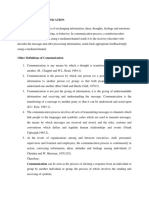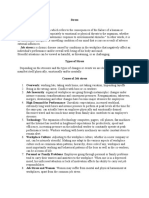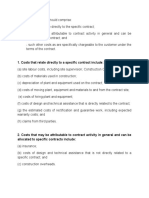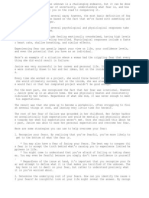Social Psychology
Social Psychology
Uploaded by
RaxCopyright:
Available Formats
Social Psychology
Social Psychology
Uploaded by
RaxOriginal Description:
Original Title
Copyright
Available Formats
Share this document
Did you find this document useful?
Is this content inappropriate?
Copyright:
Available Formats
Social Psychology
Social Psychology
Uploaded by
RaxCopyright:
Available Formats
NOTE 4 COMMUNICATION
What is communication?
Communication is a process that involves exchange of information, thoughts, ideas and
emotions. It involves a sender who encodes and sends the message, which is then carried
via the communication channel to the receiver where the receiver decodes the message,
processes the information and sends an appropriate reply via the same communication
channel.
Types of communication
Communication can occur via various processes and methods and depending on the
channel used and the style of communication. There can be various types of
communication.
(a) Verbal communication: Verbal communication is further divided into written and
oral communication.
1. Oral communication refers to the spoken words in the communication process.
2. Written communication can be either via snail mail, or email.
(b) Non-verbal communication: Non-verbal communication includes the overall body
language of the person who is speaking
1. Gestures
2. Body language and posture
3. Eye gaze
4. Appearance
Types of Communication Based on Style and Purpose
(c) Formal Communication: Formal communication includes all the instances where
communication has to occur in a set formal format. Typically this can include all sorts of
business communication or corporate communication.
(d) Informal Communication: Informal communication includes instances of free
unrestrained communication between people who share a casual rapport with each other.
Informal communication requires two people to have a similar wavelength and hence
occurs between friends and family.
Communication process
The communication process is the guide toward realizing effective communication. It is
through the communication process that the sharing of a common meaning between the
sender and the receiver takes place. Individuals that follow the communication process
will have the opportunity to become more productive in every aspect of their profession.
Effective communication leads to understanding. The communication process is made up
of four key components. The communication process begins with the sender and ends
with the receiver.
The Source/Encoder
The sender begins the communication process by forming the ideas, intentions and
feelings that will be transmitted. As the sender, you are required to filter out the details
that are unimportant and focus your energy on the most relevant information. The source,
or encoder, makes the decision to communicate.
The Message
The second element of the communication is the message, or that information which is
being communicated. The source encodes an idea and then determines whether or not to
inform, persuade, or entertain.
Channel
Channels are the means (that is, pathways or devices) by which messages are
communicated. The source may speak face-to-face with the receiver, use a public address
system to talk with a hundred listeners, or talk over radio or television to million of
receivers.
Receiver/Decoder
The person (or persons) who attend to the source’s message is the receiver. The act of
interpreting messages is called decoding. Receivers decode messages based on past
experiences, perceptions, thoughts, and feelings.
Feedback
Another element in the communication process is feedback. Each party in an interaction
continuously sends messages back to the other. This return process is called feedback.
Feedback tells the source how the receiver has interpreted each message.
Barriers to communications
Barriers' are any obstacles or difficulties that come in the way of communication. They
may be physical, mechanical, psychological cultural or linguistic in nature.
(a) Physical Barriers: Physical barriers are often due to the nature of the environment.
(b) Psychological Barriers Psychological barriers such as people's state of mind.
(c) Perception barriers: We view what is said from our own mindset.
(d) Linguistics and Cultural Barriers: The use of difficult or inappropriate words in
communication can prevent people from understanding the message.
(e) Language barriers: Variations in language, accent and dialect.
(f) Gender barriers: There are distinct differences between the speech patterns in a man
and those in a woman. A woman speaks between 22,000 and 25,000 words a day whereas
a man speaks between 7,000 and 10,000. In childhood, girls speak earlier than boys and
at the age of three, have a vocabulary twice that of boys.
(g)Mechanical Barriers Channels become barrier when the message is interfered with
by some disturbance
You might also like
- Form MDocument4 pagesForm MShams Ul FatahNo ratings yet
- Folk Magic and Protestant Christianity in AppalachiaDocument35 pagesFolk Magic and Protestant Christianity in AppalachiaViktorija Briggs100% (6)
- Business CommunicationDocument15 pagesBusiness CommunicationNeeraj AggarwalNo ratings yet
- Effective CommunicationDocument7 pagesEffective CommunicationJhelo CruzNo ratings yet
- LCM Flute Diploma 2011-2015Document30 pagesLCM Flute Diploma 2011-2015Alan LuNo ratings yet
- Communication SkillsDocument18 pagesCommunication SkillsmuyajohntyNo ratings yet
- Cha 2Document25 pagesCha 2Gizaw BelayNo ratings yet
- Communication Process-Topic One to Submit(0)Document55 pagesCommunication Process-Topic One to Submit(0)altheniosimonNo ratings yet
- Ge 2 ReviewerDocument3 pagesGe 2 ReviewerIkang CabreraNo ratings yet
- Module in Purposive Com. G-5Document11 pagesModule in Purposive Com. G-5Farah Therese AdarnaNo ratings yet
- Communication Models: The Process of CommunicationDocument5 pagesCommunication Models: The Process of CommunicationDanica Paula MamawagNo ratings yet
- Speech and Stage Arts - Module 1Document16 pagesSpeech and Stage Arts - Module 1Rica PajanustanNo ratings yet
- Effective Communication 1Document4 pagesEffective Communication 1V. Kavi ArasanNo ratings yet
- CLM 100 Development of Communications - Books FDocument16 pagesCLM 100 Development of Communications - Books FCollins OtienoNo ratings yet
- 6 CommunicationDocument10 pages6 CommunicationSonam DemblaNo ratings yet
- Introductions To Human Communication Notes-1Document14 pagesIntroductions To Human Communication Notes-1Sophia WambuiNo ratings yet
- Chapter 1Document20 pagesChapter 1Kim2x TamparongNo ratings yet
- MODULE 1 Oral Comm (Week1)Document10 pagesMODULE 1 Oral Comm (Week1)Ruschelle Lao50% (2)
- Types of CommunicationDocument6 pagesTypes of CommunicationMuhammad Sohaib ChaudharyNo ratings yet
- Humanities and Social SciencesDocument8 pagesHumanities and Social SciencesBinibiniNo ratings yet
- What To StudyDocument10 pagesWhat To StudySuzotto GeronaNo ratings yet
- GET 305 Engr Communication Lecture Note 24Document54 pagesGET 305 Engr Communication Lecture Note 24bennyavidimeNo ratings yet
- Communication Skills.Document21 pagesCommunication Skills.lilskatesskitterNo ratings yet
- Elements of CommunicationDocument7 pagesElements of CommunicationlenerNo ratings yet
- Reviewer-In-Pc-Module-1-8 1Document66 pagesReviewer-In-Pc-Module-1-8 1Kristy Veyna BautistaNo ratings yet
- Communication SkillsDocument23 pagesCommunication SkillsByonabye MosesNo ratings yet
- English PresentationDocument26 pagesEnglish Presentationitxmelucifer04No ratings yet
- Communication Training ModuleDocument25 pagesCommunication Training ModuleMosneagu AndreeaNo ratings yet
- LESSON 1 Purposive CommDocument34 pagesLESSON 1 Purposive CommCarmie Lactaotao DasallaNo ratings yet
- Communication Skills 2 1Document34 pagesCommunication Skills 2 1MUHWANA TIMOTHYNo ratings yet
- PPP 1 PurposivecomDocument49 pagesPPP 1 PurposivecomJoselito GelarioNo ratings yet
- Topic1fundamentals of CommunicationDocument23 pagesTopic1fundamentals of Communicationapi-366561602No ratings yet
- Communication Derived From The Latin Word Communis-1 PDFDocument37 pagesCommunication Derived From The Latin Word Communis-1 PDFPrecious njeriNo ratings yet
- Communication SkillsDocument5 pagesCommunication SkillsVitthal Patel50% (2)
- Unit On1Document13 pagesUnit On1SydNo ratings yet
- Business CommunicationDocument50 pagesBusiness Communicationrajabanisa12No ratings yet
- ClassXITCommunicationSkills PDFDocument7 pagesClassXITCommunicationSkills PDFwv8bgckjsc100% (1)
- POM.pdf.PDF_20240906_104738_0000Document7 pagesPOM.pdf.PDF_20240906_104738_0000premrajendiran2427No ratings yet
- BAS 301Document107 pagesBAS 301sharmaankit30123No ratings yet
- About Oral CommDocument35 pagesAbout Oral CommAmelia MorenoNo ratings yet
- Etudes Francaises s1 2023-2024Document19 pagesEtudes Francaises s1 2023-2024rayhanti.2015No ratings yet
- Efcom Week 1Document24 pagesEfcom Week 1lyleisaac.illaga.23No ratings yet
- Ge 5Document7 pagesGe 5Draque TorresNo ratings yet
- Introduction To Communication Nature of CommunicationDocument9 pagesIntroduction To Communication Nature of CommunicationNAVEEN KUMAR SNo ratings yet
- CommunicationDocument19 pagesCommunicationMd. Tamim IqbalNo ratings yet
- Lesson 1 - Purposive CommunicationDocument26 pagesLesson 1 - Purposive Communicationcristina castilloNo ratings yet
- Unit - 1 Communications: 1.meaning of CommunicationDocument28 pagesUnit - 1 Communications: 1.meaning of CommunicationSharanu HolalNo ratings yet
- Chapter 1 - COMMUNICATION PROCESSES, PRINCIPLES, AND ETHICSDocument7 pagesChapter 1 - COMMUNICATION PROCESSES, PRINCIPLES, AND ETHICSRujean Salar AltejarNo ratings yet
- Communication Skills Brief NotesDocument13 pagesCommunication Skills Brief NotesHarshit AgarwalNo ratings yet
- The Process of CommunicationDocument2 pagesThe Process of CommunicationLeenas MagnaNo ratings yet
- Uc 13Document11 pagesUc 13Tadesse DakabaNo ratings yet
- GNS 102 - COMMU-WPS OfficeDocument4 pagesGNS 102 - COMMU-WPS Officelawanyahaya21No ratings yet
- Copy of Doc_lm_b.c.a. New_1 2Document14 pagesCopy of Doc_lm_b.c.a. New_1 2raisinghdaksh2No ratings yet
- Unit 1 Managerial CommunicationDocument34 pagesUnit 1 Managerial CommunicationGamers 4 lyfNo ratings yet
- Communication Skills - HandoutDocument18 pagesCommunication Skills - HandoutAdelite sabiriNo ratings yet
- Oral CommunicationDocument37 pagesOral CommunicationHamid YahyaNo ratings yet
- Communication Skills For Lawyers-2Document63 pagesCommunication Skills For Lawyers-2Eric TemuNo ratings yet
- Introduction To Oral CommunicationDocument8 pagesIntroduction To Oral CommunicationJoyce Ann Mauricio100% (1)
- COR1 Oral Communication in ContextDocument63 pagesCOR1 Oral Communication in ContextJohn Kennedy QuinesNo ratings yet
- CommSkills Sem2 UNIT 1Document14 pagesCommSkills Sem2 UNIT 1kaushal chafeNo ratings yet
- BC - Sem I - MaterialDocument25 pagesBC - Sem I - MaterialManjulaNo ratings yet
- Listen, Speak, Lead: Elevate Your Success with Effective CommunicationFrom EverandListen, Speak, Lead: Elevate Your Success with Effective CommunicationNo ratings yet
- Unit 8 - Liner Companies and Conferences PDFDocument89 pagesUnit 8 - Liner Companies and Conferences PDFRax100% (1)
- My ProjectDocument5 pagesMy ProjectRaxNo ratings yet
- Unit 4 ProcedureDocument11 pagesUnit 4 ProcedureRaxNo ratings yet
- Social PsychologyDocument4 pagesSocial PsychologyRaxNo ratings yet
- Social PsychologyDocument3 pagesSocial PsychologyRaxNo ratings yet
- Social PsychologyDocument6 pagesSocial PsychologyRaxNo ratings yet
- Agricultural DronesDocument3 pagesAgricultural DronesRaxNo ratings yet
- CII UNIT 2 Customs DeclarationDocument23 pagesCII UNIT 2 Customs DeclarationRaxNo ratings yet
- Donaldson, Bess Allen (1937) - Koran As MagicDocument12 pagesDonaldson, Bess Allen (1937) - Koran As MagicAndreaNo ratings yet
- Lesson XIII: Vocabulary and ExercisesDocument3 pagesLesson XIII: Vocabulary and ExercisesYuri SterckNo ratings yet
- EJHM - Volume 89 جامعه الزقازيقDocument9 pagesEJHM - Volume 89 جامعه الزقازيقفاطمة الزهراء أسامةNo ratings yet
- 2021-EO New Localized Guidelines August GCQDocument5 pages2021-EO New Localized Guidelines August GCQDennis CosmodNo ratings yet
- Script DocumentaryDocument3 pagesScript DocumentaryUsran Ali BubinNo ratings yet
- TEXT of Novel Hard Times by Charles DickensDocument381 pagesTEXT of Novel Hard Times by Charles DickensHANI AHMEDNo ratings yet
- MS1200NF Mineral Sorting For Rare MetalDocument2 pagesMS1200NF Mineral Sorting For Rare MetalnataNo ratings yet
- Learning EvidenceDocument5 pagesLearning EvidenceShaneil MatulaNo ratings yet
- Supply Chain Management in The Building ConstructiDocument25 pagesSupply Chain Management in The Building ConstructiAbdulkaiyyumNo ratings yet
- 06 Cost Volume Profit RelationshipsDocument74 pages06 Cost Volume Profit RelationshipsGxjn LxmnNo ratings yet
- Sip Report..Document49 pagesSip Report..Zulquarnain100% (2)
- Hassan Nisar's Potential PlagiarismDocument1 pageHassan Nisar's Potential PlagiarismAjayPandeyNo ratings yet
- Ghana Investment Promotion Centre (Gipc) Act 865Document19 pagesGhana Investment Promotion Centre (Gipc) Act 865JeffreyNo ratings yet
- Hammer-Strength 2019 CatalogueDocument33 pagesHammer-Strength 2019 CatalogueCelso Flores TovarNo ratings yet
- bài tập ôn luyện cuối kỳ 2 G6 FPDocument30 pagesbài tập ôn luyện cuối kỳ 2 G6 FPVu Thai DuongNo ratings yet
- Task 2Document8 pagesTask 2Chin Jia YiNo ratings yet
- King ApplicationDocument75 pagesKing ApplicationJenniferNo ratings yet
- Who Was Amir Muawaih?Document9 pagesWho Was Amir Muawaih?Ahmed ShahzadNo ratings yet
- Alsmith - The Structuring Body PDFDocument362 pagesAlsmith - The Structuring Body PDFkobarnaNo ratings yet
- Contract CostsDocument4 pagesContract CostsPhilip Jhon BayoNo ratings yet
- BOQDocument4 pagesBOQMark Roger Huberit IINo ratings yet
- 12 - E2language Test IV PDFDocument26 pages12 - E2language Test IV PDFAbdullah Mohammad Ibne HaiderNo ratings yet
- How To Overcome Your Fear of The UnknownDocument2 pagesHow To Overcome Your Fear of The UnknownElias FungNo ratings yet
- Solids Handling WEMCO Self PrimerDocument4 pagesSolids Handling WEMCO Self Primermiguel_vera6592No ratings yet
- Access2013 T02 PPTDocument43 pagesAccess2013 T02 PPTArshad AyubNo ratings yet
- Input Data Sheet For SHS E-Class Record: Learners' NamesDocument4 pagesInput Data Sheet For SHS E-Class Record: Learners' NamesTek CasoneteNo ratings yet
- 18PS88 Shabalm!Document2 pages18PS88 Shabalm!Trần Yến NhiNo ratings yet

































































































